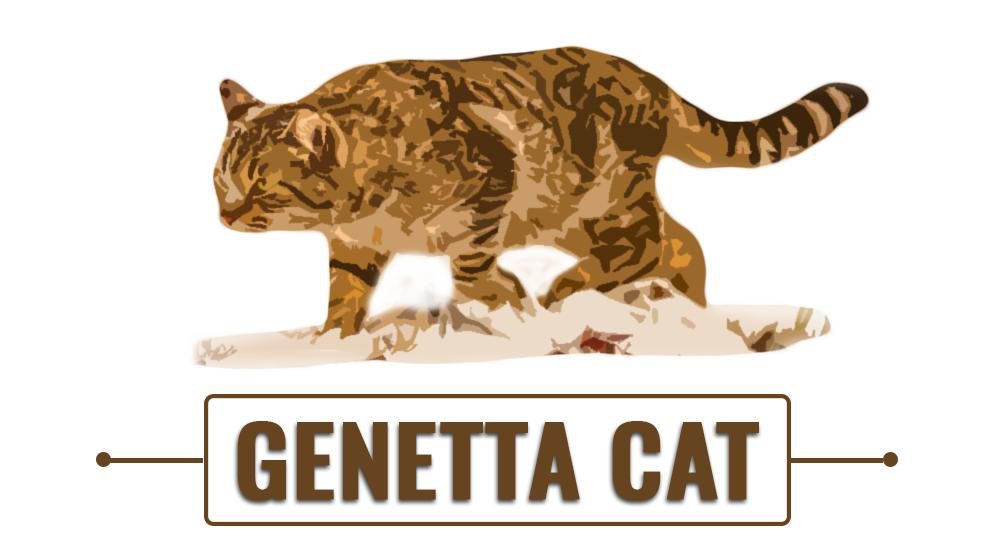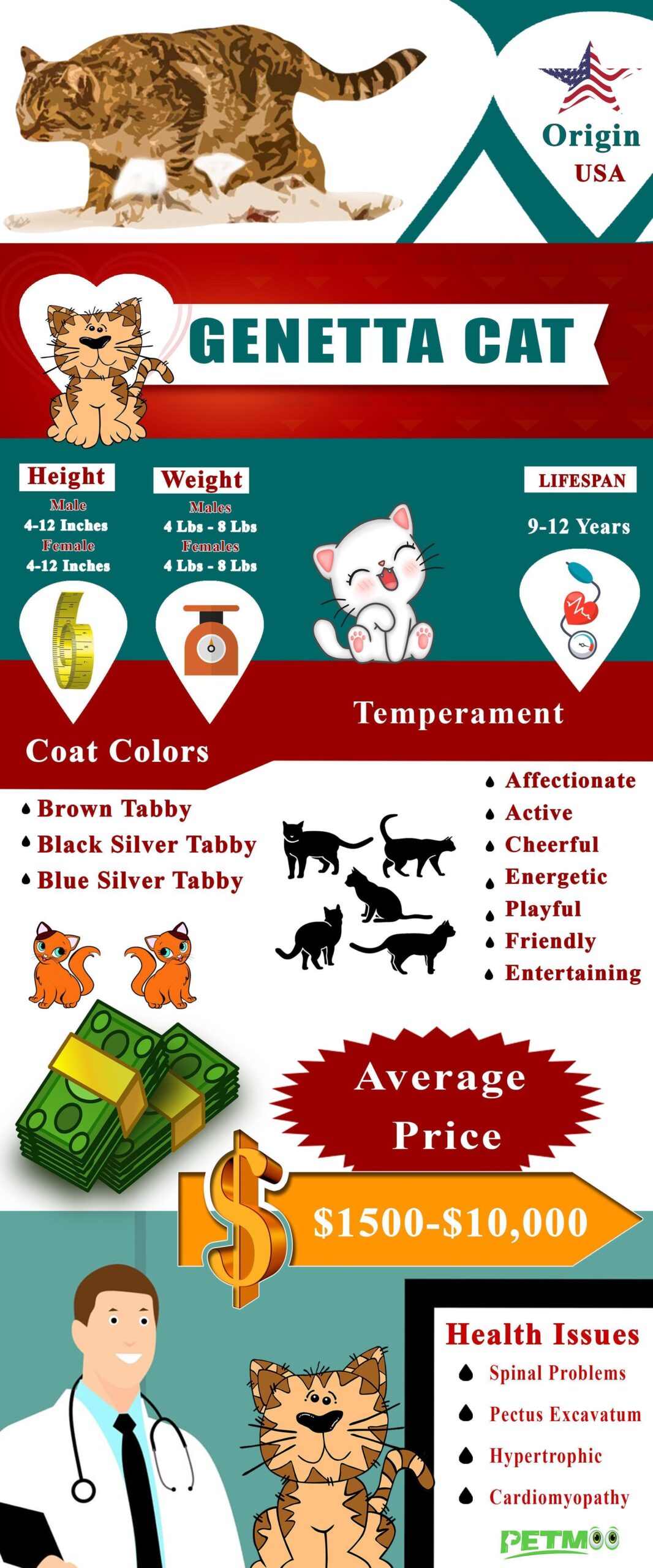Cat Pregnancy Calculator And Timeline
If you haven’t heard of the Munchkin-Bengal cat mix – or simply the Genetta cat breed, you don’t have to feel bad: you’re not alone.
The newest feline breed Genetta is still being developed by breeders at Pawstruk Cattery. Though, this relatively new cat breed is designed to have some of the physical characteristics of the Genet, which is a cat-like omnivorous mammal.
In terms of its species classification (taxonomy), they are not part of the cat family but related to the cat species Felidae and also ferrets. This designer mixed breed isn’t even officially recognized by The International Cat Association yet and still very much a “work in progress”.
This short-legged cat with a marbled or spotted coat is developed from a variety of breeds such as munchkins, Bengals, and others.
And because of its coat pattern, this dwarf cat resembles the spotted African Genet.
The breeders at Pawstruck Cattery developed this breed to provide customers who wanted to own a Genet or who just liked the look of a Genet but wanted a pet with more docile temperament but for obvious reasons can’t own one.
Because owning a Genet require special care for the right owners as they are African based wild animals.
Shannon Kiley at Pawstruck Cattery had the idea to create a new cat that would satisfy those exotic animal enthusiasts and it was on December 13, 2006, that the first litter of Genetta kittens was born.
Although the Genetta Cat resembles a wild Genet in appearance, no Genets were used to create this breed and this is created to be a domestic feline.
This breed has been developed by crossing Munchkins, SBT Bengals, and Savannahs. Moreover, the Serval, Asian Leopard, and Oriental Shorthairs lineages might be incorporated into the Genetta breed at some point in the future.
At present, the Genetta Cat is listed as an experimental breed by The International Cat Association (TICA). Genettas is also registered by Rare and Exotic Feline Registry (REFR) and The Dwarf Cat Association (TDCA).
The Genetta’s breeders are working on to get it registered by TICA and other major cat registries in the future.
Genetta Cat Breed Characteristics Sheet
- Origin: USA
- Size: Small
- Purebred: Yes
- Lifespan: 9-12 Years
- Height: Male:4-12 Inches (10 – 30 Cm), Female: 4-12 Inches (10 – 30 Cm)
- Weight: Males: 4 Kg-8 Kg; Females: 4kg To 8kg
- Coat Appearance: Short, Thick, Tight But Soft Coat
- Coat Colors: Brown Tabby, Black Silver Tabby, Blue Silver Tabby
- Temperament: Affectionate, Active, Cheerful, Energetic, Playful, Friendly, Entertaining
- Good With Children: Yes
- Intelligence Level: High
- Good With Pets: Yes
- Hypoallergenic: No
- Grooming: Average
- Shedding: Minimal
- Suitable For Apartments: Yes
- Good For First Time Owners: Yes
- Health Issues: Spinal Problems, Pectus Excavatum, Hypertrophic Cardiomyopathy
- Litter Size: 3- 6 Kittens
- Average Price: $1500-$10,000
Genetta Cat History
As earlier mentioned, the Genetta cat is a new breed of cats that resembles African genets and was developed by the breeders at Pawstruck Cattery.
African Genets are also increasing in popularity as exotic pets because of their unique behaviors and beautiful patterns.
They look like a cross between a raccoon and a leopard that is genetically more closely related to the civet and mongoose.
These nocturnal animals are active, agile, and solitary creatures that require special care but for the right owner, they can make fun pets.
If you’ve not seen a genet personally, imagine a kitten with the spots of a cheetah, the pointy face of a ferret and the tail of a lemur.
Of course, they are good-looking but they are not proper household pets. There are over 30 different kinds of genets but the Common Genet that is native to Europe, the Middle East, and Africa is the one most commonly kept as a pet.
Breeder Shannon Kiley of the Pawstruk Cattery started the process in 2006 when she started with a goal of creating a domestic cat that appeals to genet fans but was friendly enough to be a house pet.
The first Litters of Genetta cats were born on December 13, 2006. Even though Genetta cats are intended to look like genets, there are no genets used in the creation and breeding process.
The end breed was a mixed bag of genetics that mainly combined some of the largest cat breeds– like the Bengal and Savannah– with munchkin cats to produce an exotic-looking designer breed.
Currently, Pawstruk Cattery is also considering adding some wild cat genes, like the Asian Leopard and Serval, to the mix. This is where we have to bite our tongue concerning ethics.
Genetta Cat Appearance And Coat Color
Face
They have a Narrow wedge-shaped head that is longer than it is wide with a Weasel like a muzzle. Their ears prolong to the lines of the wedge with forwarding stance and rounded tip of ear should be only a little smaller than the base of the ear.
They have large eyes, set with a slight slant toward the nose. The Color of eyes should be deep amber, dark brown or brilliant green.
Body
Long, tubular, medium-sized body with equivalent width at hips and shoulders. Medium boned, very firm, long lean muscles proportioned to carry the body length and weight. Short legs with front legs are even with hind legs. Preferred Leg length is less than 8”.
Coat Color
They have a very short, thick, tight but soft coat with a pelt like quality which is glossy or glittered. They have a Spotted or Marbled coat.
For spotted cats, solid or Rosettes spots aligned horizontally or maybe at random. Spotted belly and ticking in the coat must be lesser. There should be distinct black rings in tails.
For marbled cats, marbling is acceptable given that it does not look like a bulls-eye pattern like in classic tabbies. The tail can be solid or ringed in color.
- Brown Tabby
- Black Silver Tabby
- Blue Silver Tabby
Pattern
Spotted or marbled coat
Genetta Cat Life Expectancy
We can begin with the fact that its lifespan is 9-12 years and can reach up to 15 years. When it comes to health problems, there are no reported health issues.
Also due to their looks of genet, there is a suspicion of genetic diseases of a genet. Remember that they are bred to look like a genet and It’s doesn’t inherit any genet genes so it is generally harmless.
Having said that, it is worth knowing the diseases of the parental cat breeds such as Bengal and Savannah cats. It seems like common sense, there is likely to be a degree of hereditary illness from parental breeds.
Genetta Cat Temperament
Highlights
The parental breeds of Genetta are one of the most intelligent and lively cat breeds, so there’s a quite a good chance that they will be active, alert, smart, playful, social, affectionate, energetic and friendly.
- Family-friendly: Typically, the “parent” breeds are very affectionate and docile They are known to be very devoted to their human counterparts so there’s a good chance the Genetta will be, too.
- Active & energetic: These aren’t lethargic cats… that’s for sure! They tend to follow you from room to room. They love to run, play and will probably ask to be petted and will love to play with you.
- Dog-friendly: These are easygoing cats that can live in harmony with dogs as long as your dog is also cat-friendly. They fit in well with families who have children and other pets. curious and Affectionate, your Genetta and your dog will love to go on adventures together
- Prone to separation anxiety: Forget about Genetta, if you are looking for an aloof cat. Genettas are like puppy dogs and will actually come looking for you for cuddles.
- Trainable: In general, cats aren’t as trainable as dogs but Genettas are extremely smart. They are far from being shy as they like to play games, love to play ‘fetch!’ and can be taught to do tricks.
Again, remember that with any designer breed animal (including those that are genetically engineered!), there are no guarantees when it comes to personality. However, since all of the breeds used to make the Genetta have the above traits in common, there’s a really good chance their offspring will, too.
Who should own Genetta cat?
- Families with older children
- Active singles and seniors
- All Cat loving families who have enough time to devote to an active, intelligent and attention-seeking pet
Genetta Cat Grooming
As far as grooming is concerned, the Genetta cat is quite on a low-maintenance side. All cats shed to some degree (sorry, we forgot about Sphynx cat), but the Genetta is a low shedder due to pelt-like, smooth and tight coat.
On the whole, brushing your kitty weekly once is more than enough just to help with lowering the chance of hairballs.
They are pretty good about grooming themselves, so you may not even need to do that!
Genetta Cat Health Problems
There are no potential health problems reported as of now, however, Genetta breeding’s ethical concerns can raise some health concerns. Furthermore, it’s also good to assume the potential health problems as the Genetta is made up of so many different breeds.
Spinal Problems
Despite being mostly healthy, Munchkins are prone to lordosis, a rare spinal condition whereby the spine muscles do not grow to their full length. This results in the spine to ‘subside slightly’ and bend into the body.
The range of severity varies from mild to severe and none of them make for an easy life for a cat. If it’s very bad, their spine squeezes to the point of paralysis and results in death.
Pectus excavatum
Pectus excavatum (concave chest) is a structural deformity of the chest and the caved chest look gives the cat a sunken appearance. This genetic deformity is also known as ‘funnel chest’.
This can either be present at birth or develop often early in the cat’s life. This defect is not bred specific and it does have a higher propensity in munchkins( and maybe Genetta cats) than full-sized cats.
Hypertrophic cardiomyopathy
Let’s look on the Bengal side of things, heart conditions are a predominant issue among Bengal cats, which means Genetta cats may inherit certain conditions.
The most common heart condition is hypertrophic cardiomyopathy, which is caused by thickening of the inner muscle of the heart and consequently, blood flow is broken up which affects the heart function.
In Bengals, this is a hereditary condition and causes enlargement (hypertrophy) of the heart muscle that will eventually weaken the cat until they can barely move.
Eye Problems
Again, this comes from the Bengal side. They are prone to cataracts. Another eye disorder Bengals are prone to suffer from is Entropion.
This is a very painful condition where the cat’s eyelids become inverted or rolled inwards. Immediate treatment is necessary because if left untreated, it can lead to loss of vision altogether.
Progressive retinal atrophy is a painless inherited disease of the retina that causes the rods and cones in the cats’ eyes to degenerate, which leads to blindness.
How Much Does A Genetta Cat Cost?
The price will vary according to height and coat pattern, a fraction of wild blood (if any). Standard Genettas may range from $1500-$10,000 while Non-standard Genettas(long-legged) may range from $250-$3000.














